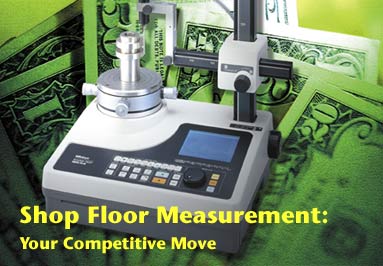|
|
|
|
Today's Specials |
|
|
|
|
Article

Moving form measurement devices to the shop floor is the next logical step in the migration to real-time measurement.
by Robert Wasilesky |
Take a peek into the machining cells at progressive large-volume manufacturers these days, and you'll likely see more form-measuring devices cropping up on the shop floor, next to the machines, measuring roundness, surface roughness or contour virtually in real time. Then take a peek at those same manufacturers' productivity, yield and customer- reject numbers, and you'll see measurable improvements. One follows the other--it's as simple as that. You'll see such practices mostly in the manufacturing cells of first- and second-tier automotive suppliers, where ISO 9000 and QS-9000 are the driving forces. But near-machine form measurement is also expanding among manufacturers of power transmission components and electronic parts. It's increasingly prevalent in the manufacture of components that are safety-or finish-sensitive, have high added value, or require 100-percent inspection. The more grinding, polishing, superfinishing, precision turning, boring and reaming you see, the more near-machine form measurement you'll find. The same goes for massive parts, because it's easier to bring the measurement function to the work piece. The next logical move Near-machine form measurement isn't any revolution in quality assurance; it's just the next logical move in the inevitable migration to real-time inspection and measurement. The migration is occurring for the same reasons that coordinate measuring machines (CMMs) and other dimensional measuring devices have been moved to the plant floor for real-time measurement and integration into manufacturing and process control. First, the global market is demanding higher quality and ISO 9000/QS-9000 adherence, which favors real-time measurement. More and more form-related callouts are showing up on part prints. Second, real-time inspection's benefit for process control has been so long-proven and so widely accepted that it's no longer seriously questioned. It's axiomatic that the closer to real time you can make a measurement, the more in control your process will be. Likewise, the better your quality reputation with customers will be. This applies as much to a cylindricity check with a round test as to a length or width measurement with a CMM. If the print specifies a parameter to a given tolerance, the closer to real time that you check that parameter the better--better for quality, process control and the bottom line. For instance, several engine builders have integrated surface roughness testing into their engine-deck milling operations to make sure the mating parts seal properly in the finished engines. They originally did it to satisfy ISO 9000/QS-9000 requirements, but they found that real-time surface measurement so cut the incidence of seal failures that the equipment more than paid for itself in a matter of weeks. Given the cost of disassembling an engine vs. the $1,500 price tag for a shop floor surface roughness tester, the payoff didn't take very long. Why choose real-time form measurement? The expansion of real-time form measurement is largely due to its lower price, as the engine-deck case illustrates. Additionally, today's measuring devices are robust and user-friendly. And, as the number of shop floor form measurement applications increase, so does the availability of lower-priced instruments tailored exactly to specific needs. The entry-level roundness indicator that cost $30,000 in 1989 now runs about $10,000. Surface roughness units cost $1,500 today vs. $3,000 in 1990. For contour measurement, a basic unit suitable for near-machine measurement starts at $20,000, vs. $40,000 in 1990. These price points--typically 50 percent to 75 percent lower than a decade ago--are for units with resolutions well within the specifications on most part-print callouts. They may not match the resolution of top-of-the line lab instruments operating in environmentally controlled clean rooms, but they are more than equal to the task of production-part auditing to present and foreseeable accuracy levels. And because they cost much less than they used to, you can afford enough of them to spread them around where they'll do the most good. For instance, at less than $10,000, the Mitutoyo RA114 Roundtest is the least expensive roundness-measuring instrument in its class. It's easy to use, and it handles 99 percent of the shop floor roundness measurements required on today's part prints. The unit has a built-in printer and RS-232 port for connectivity. The enhanced, automatable RA116 includes a PC with software able to store historical data for the operation and highlight trends. The near-machine models of today's form measuring equipment don't need the cleanroom atmosphere and pinpoint temperature control of older models. For instance, the new breed of affordable plant-floor form instruments performs as well at 60¥F to 80¥F as a 1990-era lab instrument in a temperature-controlled cleanroom. They measure at submicron levels right on the plant floor, next to a machining or turning center making chips by the bucket. With proper fixturing, which is key, near-machine form measurement can be a one-keystroke operation for each measurement. Typically, the time needed per form measurement on the floor is about a quarter or less of that required to do it in the lab. Further, the cost disappears because the operator makes each measurement within the existing machine-cell cycle. Measurement is so quick and simple that it becomes feasible to increase the inspection frequency--even to 100-percent inspection. With proper fixturing, near- machine form measurement requires no more skill than it takes to chuck a part and push the start button to make chips. The one exception to the "one stroke" guideline is surface measurement. Often it's wiser to run two or three measurements per piece and take the average. Even so, the operation can be very fast if planned properly. When to make the move The sooner you change to shop floor form measurement, the better off you'll be. If you make automotive OEM parts with roundness, contour or surface roughness callouts on the print, you'll need real-time form measurement to meet ISO 9000/QS-9000 standards. And you'll need to meet those standards shortly or you'll be bumped off the qualified suppliers list. Beyond ISO 9000/QS-9000 mandates, deciding when to move to real-time form measurement is really up to you. The key is to look at the cost/benefit in terms of the quality expectations of your market, i.e., the economic payoff to your operation in light of today's lower prices. In some cases, especially if you're running a job shop where customers' prints specify form- related standards and you're simply ignoring them for now, look also at product liability risks. Although at one time you couldn't afford to use real-time form measurement, today the question is, can you afford not to? How do you start moving form measurement to the shop floor? What equipment and functions should take the highest priority? From a process control standpoint, purchase your surface roughness measurement unit first. This is often the quickest and most sensitive indicator that a process has changed. The equipment is inexpensive, compact and easy to use, and it's useful as an early indicator of tool wear, breakage or failure. From a part-function standpoint, however, the priorities are different. If you produce a lot of round or contoured parts, move roundness measuring equipment out to the machine early. Unless the part meets roundness or contour dimensional specifications, it may not work right, making surface quality irrelevant. Keep selection quick and simple What should you look for when selecting equipment? First, remember that you're buying a dedicated single-purpose production device, not a general-purpose lab instrument. Focus on cost effectiveness to do the single part-auditing task at hand--forget about versatility. Also focus on the lowest-priced unit that can reliably achieve the resolution needed to meet present and anticipated print specifications covering form measurement--and nothing more. A resolution of 1 µin. is more than enough for shop floor form measurement. As with many measuring instruments, the cost of form measurement devices rises exponentially with resolution. Don't waste money on resolution or "neat" features, which you'll never need on the plant floor. Dollar for dollar, you're better off with two basic near-machine form instruments placed right in the cells than with a single "overqualified" instrument placed where it can be shared. Meet the new breed To give you a perspective of what's available today and some of the selection issues to consider, here's a quick rundown of current Mitutoyo equipment suited for real-time form measurement out on the shop floor.
For three-axis work, particularly cylindricity, it's necessary to spend more. For about $44,000, the fully programmable model 426 unit also handles symmetry, standard and spiral cylindricity, runout, and total indicated runout (TIR). In effect, it's a polar CMM. A digital adjustment table speeds and simplifies work piece centering and leveling for higher throughput.
For measuring waviness or microcontours or to measure hard-to-reach surfaces, you'll need to step up to a higher-end product. Mitutoyo's model SV402, priced below $10,000, utilizes a "skidless" probe design, which is more compact and versatile than skid-type probes.
Avoid overspending When evaluating brands or models, always consider performance for the dollar for the specific job at hand. Within performance, be sure to weigh speed, ease of use, and robustness and connectivity along with resolution--always for the dollar. Look also at the company behind the product. You're global; are they? Compare experience in shop floor measurement generally. Ask about price and speed of service. Shop floor measurement equipment sees heavier duty than lab equipment, especially in 100-percent inspection situations. So speed, economy of repair and economy of servicing become more important. Because you're buying a system to fit into your production operation, also look at the candidate's turnkey capability: instrument, software, fixturing, installation, training and support. The job will go more smoothly, and you'll avert delays and finger pointing if something goes wrong later on. One-stroke fixturing buys you speed One big difference between the design of general-purpose lab models and dedicated shop floor units is the importance of measurement speed. Shop floor form measurement equipment can actually pay for itself with testing cost savings to the extent that you design the operation for speed. You don't want measurement to slow production, so it must fit in with the cell operator's existing rhythm. With a little foresight and wise investment in fixturing, this can usually be done. But think the operation through before committing to the equipment. Design "single keystroke" operation for each measurement, and select fixturing that both minimizes and tolerates setup error. To this end, plan to spend more on fixturing, as long as it speeds the operation sufficiently. The fixturing may cost more than the instrument itself, but if it gives you single-key measurement and error-minimizing setup, it will pay for itself quickly. Reputable instrument makers will be happy to advise you on fixturing. At one crankshaft manufacturer, a series of measurements that used to take an hour per unit in the lab is now done in a few minutes on the shop floor. The difference is in the fixturing. Your equipment won't necessarily need custom fixturing. Start with the standard fixtures available as accessories from instrument manufacturers and ask them for help with custom fixturing. Their experience will save you time and produce a fixtured setup that aids the process rather than slowing it down. Sixfold growth seen What's ahead for real-time form measurement? Today, only about 5 percent of the people who should be doing it actually are doing it. Some may not feel the need because they don't have an ISO 9000 or QS-9000 deadline staring them in the face, as do automotive parts suppliers. Others are adopting a "wait and see" attitude. Still others may see form-related callouts on customers' prints but simply ignore them for now because they don't want to spend the money. This is an unnecessary risk--especially with the new affordability of shop floor form instruments. Progressive manufacturers of high-volume round and contoured parts are increasingly pushing the migration of form measurement to the shop floor. And they're reaping the benefits in process control and competitive edge. The leaders will get both benefits, the followers just the former. Real-time form measurement is expected to expand at least sixfold during the next five years--and to pay for itself out of product cost savings and increased yields, as well as ISO 9000/QS-9000 compliance. If you wait for those requirements to force you into real-time form measurement, you're missing the point--and a real competitive opportunity. The price of entry has come down dramatically. The next move is up to you. About the author Robert Wasilesky is form products sales manager for Mitutoyo/MTI Corp. Prior to joining Mitutoyo, Wasilesky worked for eight years at Hommel America, one of the premier form measuring product manufacturers in the United States. His expertise spans the entire range of form measuring products, including roundness testing, contour tracing and surface roughness measurement. To contact Wasilesky, write to Mitutoyo/MTI Corp., 45001 Five Mile Road, Plymouth, MI 48170, or e-mail rwasilesky@qualitydigest.com . |
Menu Level Above
This Menu LeveL
Menu Level Below
Copyright 1999 QCI International. All rights reserved.
Quality Digest can be reached by phone at (530) 893-4095. E-mail: Click Here


